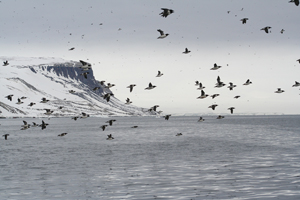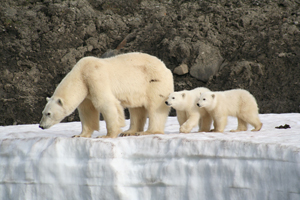Hinlopenstretet's wildlifeBy Øystein Overrein
You can register your observations of marine mammals around Svalbard in the Norwegian Polar Institute’s database Marine Mammals Sightings. 

Hinlopenstretet is full of life in April and May, when the seabirds return. There is lots of noise out in the sound, as the little auk, Brünnich’s guillemot and northern fulmar all make their presence known. Most birds go to the western part of Hinlopenstretet: from Lomfjorden and southwards. Alkefjellet to the South of Lomfjorden is the largest bird cliff in the area with several hundred thousand black-legged kittiwakes and as many Brünnick’s guillemots. There are also several colonies of northern fulmar in the area, and little auks nest scattered in Hinlopenstretet. Brünnich’s guillemots nest in many colonies, including on the island of Wahlbergøya. Black-legged kittiwakes and black guillemots also breed in several of the colonies, most of them west of Hinlopenstretet, but also around Wahlenbergfjorden. One of the colonies is on Selanderneset. Common eiders also nest in many places, but the locations have been very poorly mapped. However, there is known to be a large colony on the island of Lemströmøya, north of Wahlbergøya. Polar bears are common in the Hinlopen area. Normally a few summer bears can be spotted on the islands in Hinlopenstretet or around the bird cliffs. They can show up where you least expect it, as was experienced by a party who came here to map the waters in 1995. Two people were attacked by a young bear during a landing on the island of Kiepertøya in the south of Hinlopenstretet. Equipped with just a 22 calibre pistol, they carried inadequate protection.. The polar bear fatally injured one of the men. Such bears have very little access to food and can become unpredictable and relatively desperate. In August 2002 the remains of a young polar bear were found on the same island. It had been killed and partially eaten by another, larger bear. Another interesting polar bear observation was made from a helicopter during the same inspection in 2002: a large male bear had settled on the top of the island of Wilhelmøya. It lay there quietly, apparently waiting for the winter and for better times. Several of the most famous and most visited haul-out sites for walrus can be found in Hinlopenstretet. Worth mentioning are Augustabukta/Torellneset and Vibebukta. Caution is paramount when groups of tourists alight, and it is to be ensured that no walrus is disturbed. Boats must keep a good distance from groups of walrus that include calves, and landings must not be made. White whales, ringed seals and bearded seals also occur in the area. The abundance of reindeer in the area varies greatly. The density is highest where the vegetation is most pronounced, such as the inner parts of Lomfjorden, at the bottom of Wahlenbergfjorden, in Palanderdalen and on Scaniahalvøya. A smaller number of reindeer are also scattered around the islands in Hinlopenstretet, and the Arctic fox can be seen on both sides of the strait. There is no doubt that the easiest place to observe foxes is around the bird cliffs. This is often also where dens can be found. Avoid entering these areas. Updated April 2009 |
The Cruise Handbook is also available in book formHard cover with numerous pictures - 249 pages - NOK 249.00 Norwegian Polar Institute |
 Norsk
Norsk